Related Research Articles

The Jiajing Emperor, personal name Zhu Houcong (朱厚熜), was the twelfth emperor of the Ming dynasty, reigning from 1521 to 1567. He was the former Zhengde Emperor's cousin. His father, Zhu Youyuan (1476–1519), Prince of Xing, was the fourth son of the Chenghua Emperor and the eldest son of three sons born to the emperor's concubine, Lady Shao. The Jiajing Emperor's era name, "Jiajing", means "admirable tranquility".
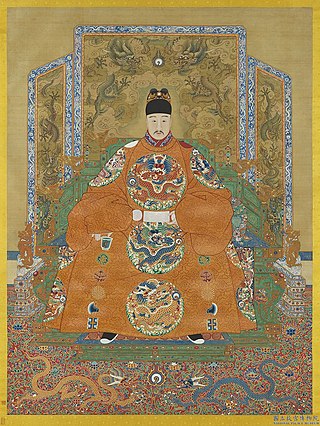
The Longqing Emperor, personal name Zhu Zaiji (朱載坖), art name Shunzhai (舜齋), was the thirteenth emperor of the Ming dynasty, reigned from 1567 to 1572. He was initially known as the Prince of Yu (裕王) from 1539 to 1567 before he became the emperor. His era name, "Longqing", means "great celebration".

The Taichang Emperor, personal name Zhu Changluo, was the fifteenth emperor of the Ming dynasty. He was the eldest son of the Wanli Emperor and succeeded his father as emperor in 1620. However, his reign came to an abrupt end less than one month after his coronation when he was found dead one morning in the palace following a bout of diarrhea. He was succeeded by his son, Zhu Youjiao, who was enthroned as the Tianqi Emperor. His era name, "Taichang", means "grand prosperity." His reign was the shortest in Ming history.
The Ming Shilu contains the imperial annals of the emperors of the Ming dynasty (1368–1644). It is the single largest historical source for the dynasty. According to modern historians, it "plays an extremely important role in the historical reconstruction of Ming society and politics." After the fall of the Ming dynasty, the Ming Shilu was used as a primary source for the compilation of the History of Ming by the Qing dynasty.
The literary inquisition, also known as speech crime (以言入罪), refers to official persecution of intellectuals for their writings in China. The Hanyu Da Cidian defines it as "the ruler deliberately extracts words or phrases from intellectual's writings and arbitrarily accuse him in order to persecute him" ("旧时谓统治者为迫害知识分子,故意从其著作中摘取字句,罗织成罪"). The inquisition took place under each of the dynasties ruling China, although the Ming dynasty was particularly notorious for the practice. In general, there are two ways a literary inquisition could be carried out. First is that the conviction came from the writing itself. That is, the writing was the direct cause of the persecution. The second is that the writing was used as a tool to provide legitimate evidence for a predetermined conviction. Such persecutions could owe even to a single phrase or word which the ruler considered offensive. Some of these were due to the naming taboo, such as writing a Chinese character that was part of the emperor's personal name. In the most serious cases, not only the writer, but also their immediate and extended families, as well as those close to them, would also be implicated and killed.
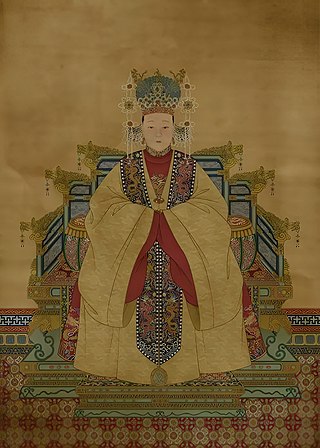
Empress Xiaoduanxian, personal name Wang Xijie, was empress consort of the Wanli Emperor. She was the longest serving empress consort in Chinese history.
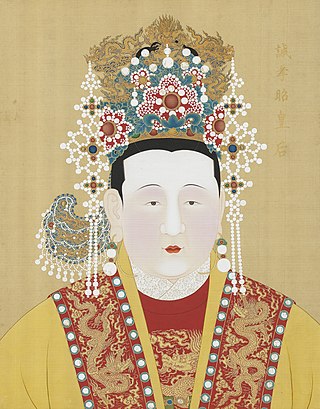
Empress Chengxiaozhao, of the Zhang clan, was a Chinese empress consort of the Ming dynasty, married to the fourth Ming ruler, the Hongxi Emperor. He only ruled for one year, so she then served as Empress dowager after the accession of her son the Xuande Emperor. She later served as the Regent of China during the minority of the reign of her grandson, Emperor Yingzong of Ming, from 1435 until 1442.

Lingchi, translated variously as the slow process, the lingering death, or slow slicing, and also known as death by a thousand cuts, was a form of torture and execution used in China from roughly 900 CE up until the practice ended around the early 1900s. It was also used in Vietnam and Korea. In this form of execution, a knife was used to methodically remove portions of the body over an extended period of time, eventually resulting in death.
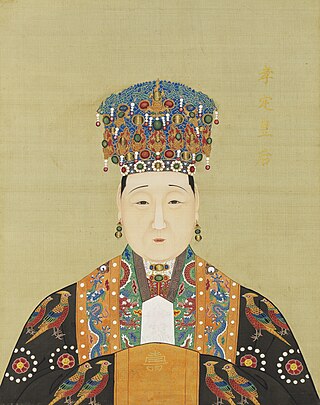
Empress Dowager Xiaoding, of the Li clan, was the mother of the Wanli Emperor. She was the nominal Regent of China during the minority of her son from 1572 to 1582. She became known in history under her posthumous name, Xiaoding.
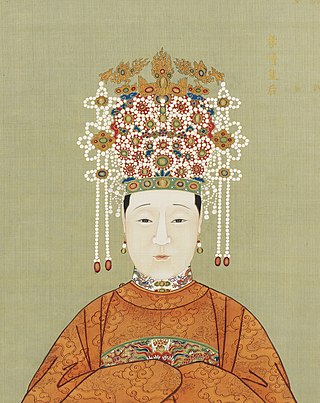
Empress Dowager Xiaojing, of the Wang clan, was a Ming dynasty concubine of the Wanli Emperor and the biological mother of the Taichang Emperor. She was primarily known during her lifetime as Consort Gong, but is most commonly referred to by her posthumous name.
Noble Consort Zheng (1565–1630), was a Ming dynasty concubine of the Wanli Emperor. She is known for having been his most beloved consort and, in an attempt to please her, he tried to make her son his heir apparent. This act caused over a decade of conflict and factionalism in the imperial court.
Princess Rongchang (1582–1647) was a Chinese princess, the eldest child of the Ming dynasty Wanli Emperor and his primary wife's, Empress Xiaoduanxian, only child.
Princess Shouning (1592–1634) was a Ming dynasty princess, the seventh daughter of the Wanli Emperor and third daughter of Noble Consort Zheng. She was a particularly favoured child of her father, who ordered her to visit the palace once every five days after her marriage.
Consort Duan, of the Cao clan, was a Ming dynasty concubine of the Jiajing Emperor. She was one of the emperor's most beloved concubines, but was implicated in an assassination attempt and subsequently executed.
The Palace plot of Renyin year, also known as the Palace Women's Uprising, was a Ming dynasty plot against the Jiajing Emperor, where sixteen palace women attempted to murder the emperor. It occurred in 1542, the 21st year of the reign of the Jiajing Emperor and the renyin year of the sexagenary cycle, hence its name.
Zhu Changxun (1586–1641) was the third son of the Ming dynasty Wanli Emperor. His mother, Noble Consort Zheng, was a favoured concubine and, in efforts to please her, the emperor attempted to have Zhu made heir apparent, but failed to overturn the rule of primogeniture. After the fall of the Ming, however, Zhu's son, Zhu Yousong, became emperor of the Southern Ming dynasty.
Prince of Xing, was a first-rank princely peerage used during Ming dynasty, the principality was created by Chenghua Emperor for his fourth son, Zhu Youyuan. As Zhu Youyuan only survived son, Zhu Houcong was enthroned as Jiajing Emperor, the principality was absorbed into the crown.
Queen Hyeondeok, of the Andong Gwon clan, was the primary consort of Crown Prince Yi Hyang. She died giving birth to the future Danjong of Joseon and was posthumously honoured as Queen Hyeondeok (현덕왕후) in 1450, later demoted by Sejo of Joseon after he deposed her son, then restored by Jungjong of Joseon.
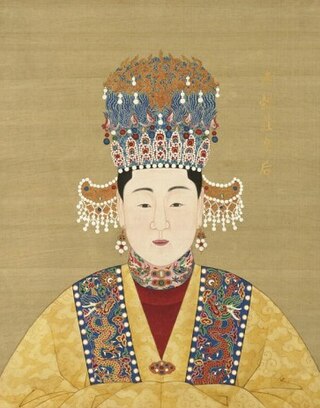
Empress Xiaoyizhuang, of the Li clan, was a Chinese imperial consort of the Ming dynasty, she was the first wife of the Longqing Emperor. Her father is Li Ming (李铭).
References
Notes
Works cited
- History Office, ed. (1620s). 明實錄:明世宗實錄 [Veritable Records of the Ming: Veritable Records of Shizong of Ming] (in Chinese). Ctext.
- Zhang Tingyu, ed. (1739). "《明史》" [History of Ming]. Read TCM (in Chinese). Retrieved 14 October 2017.